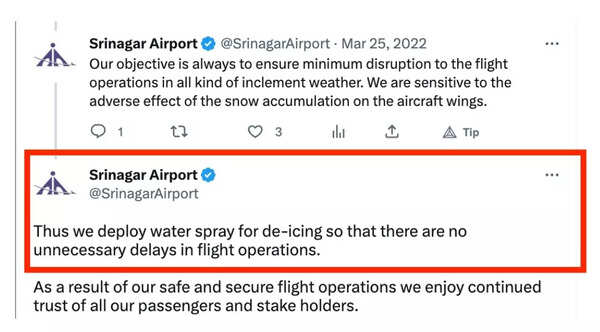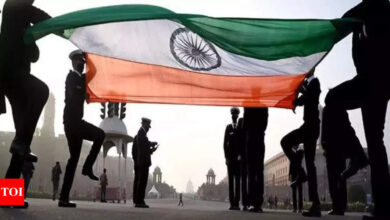Safety survey draws focus to unsafe methods used to de-ice wings of aircraft on ground | India News

[ad_1]
Safety Matters Foundation, an NGO recently carried out a quick and small sample size survey on aircraft de-icing in India. Capt Amit Singh, the founder said that the survey pointed to the fact that there is a need to develop facilities for de-icing in India to keep up with the pace of aviation network expansion.
“The big question is whether airports in India that receive snowfall are equipped with de-icing /anti-icing equipment and which fluid is being used for the purpose?,” he said. He took the example of Srinagar airport which experiences snow fall during winter months.
“An official reply received from the Airport Authority of India, Srinagar to an RTI, states that de-icing facility is not available at the Srinagar airport and no such facility has been requested by the stakeholders,” he said.
“However, contrary to the official reply to the RTI, the Srinagar airport official twitter handle posted on 25 March 2022 that they were sensitive of the snow accumulation on the aircraft wings and water spray was deployed for de-icing to prevent unnecessary delays in flight operations,” he said.

“There is a need to invest in safety systems and processes for de-icing aircraft at airports in India which are affected by adverse weather entailing flight operations on ground in icing conditions,” Capt Singh said.
In the survey, pilots operating in India have responded that they have taken-off and landed at airports under prevailing conditions of snow and freezing rain which is considered a high risk operation, said Capt Singh.
“Heated water above 60 deg C is permitted to be used but only after systems and processes have been developed and not as an ad-hoc measure by untrained and unqualified personnel,” he said. “Water as a de-icing agent does not have any hold over time and any delay in departure after the use of water is an unsafe operation. The apparent use of water spray for de-icing without any trained manpower is extremely unsafe and this practice must be stopped immediately,” he said adding that technology is essential to maintain continuity and reliability in flight operations and de-icing equipment has been used globally with much-desired results.
Amongst the respondents to the survey, 94% were flight crew and the remaining 6% comprised those working in airport operations. A total of 58% of the respondents were domiciled in Delhi which has the maximum number of flights operating to the northern region of India.
To a question if the company operations manual or relevant manuals contain policy and procedure for De-icing/Anti icing, 86% respondents answered yes while 76% responded that they or the staff are trained and certified in the procedures for De-icing/Anti-icing.
A total of 54% respondents said they had operated to or positioned at airports where de-icing/anti-icing may have been required and 62% respondents answered that they have landed at airports in India during periods of snowfall/freezing rain. On the other hand, flight crew operating to international destinations which are affected by adverse weather are trained and certified for de-icing/anti-icing operations, the manuals and SOP too have been developed, said Capt Singh.
Snow and freezing rain can cause significant accumulation of clear ice on the upper surface which will require de-icing/anti-icing measures to be taken prior to take-off. Freezing rain can overwhelm most de-icing equipment quickly. Aircraft on the ground during freezing rain may become covered in thick layers of ice which will be difficult to remove; airfield operating surfaces and runways will also be affected, and all aircraft movement on the ground may be severely disrupted.
The effects of ice on an aeroplane are wide-ranging and unpredictable. For instance: ice increases the weight of the wing, affects its lift dynamics and could turn hazardous during a take off. “A de-icing system removes an existing ice build up and an anti-ice system prevents the formation of ice on the aircraft structure. Jet aircraft systems have only anti-icing systems and they operate when the aircraft is in flight. Therefore it is even more important that any ice build up on the aircraft is removed before take-off as it reduces the lift generated by the wings, increases the aircraft weight thereby increases the runway length requirement,” said Capt Singh.
“The wings of an aircraft generate the required lift to sustain aeroplane’s flight, making it necessary for the air to flow in the least undisturbed state around the wings. The concept is called “Clean Wing” where there are no deposits of contaminants like frost, snow, ice sticking to the wing’s surface,” he said.
“Wind tunnel and flight tests demonstrate that ice, frost, or snow formations on the leading edge and upper surface of a wing can reduce wing lift by as much as 30 percent and increase drag by up to 40 percent (dependent on aerofoil shape, contaminant thickness, surface roughness, etc.). In addition, these contaminants will affect the aeroplane’s flight performance by increasing the weight, increasing stall speed, and reducing stability,” he said.
As per the USA National Transport Safety Board, fine particles of frost or ice, the size of a grain of table salt and distributed as sparsely as one per square centimeter over an airplane wing’s upper surface, can destroy enough lift to prevent a plane from taking off.
#Safety #survey #draws #focus #unsafe #methods #deice #wings #aircraft #ground #India #News





